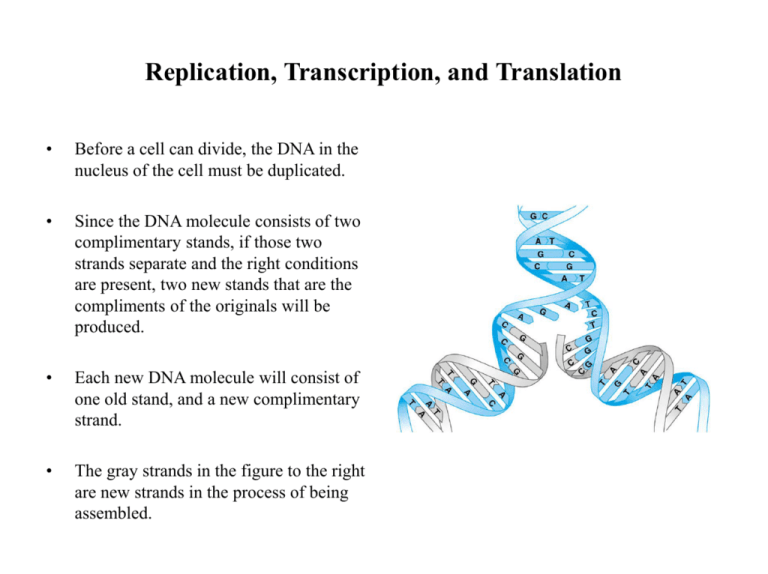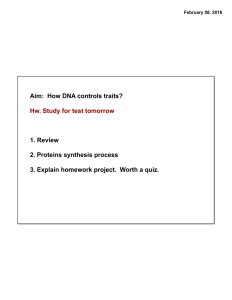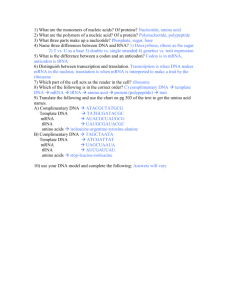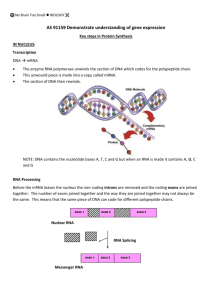Replication, Transcription, and Translation
advertisement

Replication, Transcription, and Translation • Before a cell can divide, the DNA in the nucleus of the cell must be duplicated. • Since the DNA molecule consists of two complimentary stands, if those two strands separate and the right conditions are present, two new stands that are the compliments of the originals will be produced. • Each new DNA molecule will consist of one old stand, and a new complimentary strand. • The gray strands in the figure to the right are new strands in the process of being assembled. Assembling the New Bases • The term semiconservative replication means that in the new DNA molecule there is one old and one new strand. • This is seen in the figure below. DNA Replication • Since the DNA molecule is very large, there must be a way to copy it faster than just unwinding from one end to the other! • This happens when the DNA molecule separates at many sites, forming thousands of replication bubbles. This allows parts of the DNA message to be replicated simultaneously in many locations. • DNA polymerase adds new nucleotides , while DNA ligase joints the DNA segments together. Why the fuss about DNA replication?? • As you will note when you read the textbook (if you haven’t already!) the process of DNA replication involves a number of enzymes and proteins, and it a bit more complicated than seen in the previous slide. • The important idea is that an exact duplication of the DNA message is required, so that each new cell in the body has the same set of genetic instructions as the cells that preceded it. • This also insures that every new generation of individuals has the same genetic information as his/her parents. DNA carries information that can be used to construct the proteins which form structures and regulate the body’s activities. • Protein synthesis involves two processes: transcription and translation. • In transcription the DNA message is converted into an RNA molecule. • In translation the RNA message is used to assemble amino acids into a protein chain. times, they are a changing • For many years biologists referred to the one gene-one enzyme hypothesis. It was believed that each gene controlled the production of a single protein. • This was changed to the one gene-one protein hypothesis because many proteins are structural proteins, not enzymes. • Since some proteins consist of several polypeptide chains that are linked together, the hypothesis was changed again. This time one gene-one polypeptide seemed more accurate. • As a result of the Human Genome Project, the one gene-one polypeptide hypothesis has had to be changed again! We now know that a gene can produce more than one polypeptide depending upon how the information in the gene is read. More about this later! The genetic code • The genetic code is written in the sequence of the 4 bases of DNA: A, T, C, and G. • Three bases read in sequence specify one of the 20 amino acids found in protein molecules. • A codon is the 3-base sequence for an amino acid. • The message in the DNA is transcribed into an RNA molecule, and then translated into a polypeptide The Genetic Code II • There are 64 (4X4X4) possible triplet codes, but only 20 amino acids. • As seen in the table, more than 1 triplet may code for the same amino acid. This is no problem, as long as no triplet can code for more than one amino acid. • Note that several codons can also act as start (AUG) or stop (UAA) signals. Why do we need RNA too? • There are three types of RNA produced in the nucleus: mRNA, tRNA, rRNA. • Messenger RNA (mRNA) is a copy of the DNA that codes for a polypeptide. • When the two DNA strands of a gene separate, one of the strands is transcribed into an RNA molecule with the aid of the enzyme RNA polymerase. • The RNA strand elongates until it reaches a termination signal (a sequence of bases in the DNA strand). At this time the RNA molecule is released from the DNA, allowing the DNA strands to reunite. • After production the RNA molecules leave the nucleus and enter the cytoplasm. Cleaning up the Message • • • When the genetic message is copied to make mRNA, the message contains unwanted base sequences. The ‘junk’ sequences (called introns) are removed from the message and the remaining sequences (exons) are linked together to produce a sequence of codons that will translate into a polypeptide. This process occurs before the message leaves the nucleus. Where oh where can the amino acids be? • • • • • A second type of RNA is transfer RNA, whose function is to attach to a specific amino acid and bring that amino acids to the site where polypeptides are being constructed. This RNA strand is twisted and bonded into the shape seen on the right. One end of the molecule attached to a specific amino acid. The other end has an exposed sequence of 3-bases. These are called the anticodon. How many kinds of tRNA must there be? You must know your base pairs!! • If you said 20 types of tRNA you are wrong! • There must be a different tRNA molecule for each of the possible triplets. This means 64 anticodons. The anticodons of the tRNAs each have a complimentary codon in the mRNA. For example the codon AUG would be the compliment of the anticodon UAC. The role of Ribosomes • The third type of RNA is risosomal RNA (rRNA). • Ribosomes are the ‘decoding’ units of the cell. • Each ribosome consists of two subunits, and is an assemblage of rRNA and proteins. • Ribosomes have binding sites for both tRNA and mRNA molecules. Reading the Message • • • • • An mRNA molecule attaches to a ribosome. As the ribosome moves along the mRNA, 3-base codons are exposed one at a time. A tRNA with an anticodon that is complimentary to the codon of the mRNA temporarily bonds with the mRNA. The ribosome positions the molecules so that this bonding occurs. As the ribosome continues its journey along the mRNA additional tRNAs bring their a.a. to the site of peptide synthesis. Elongation of the chain • • • • As new amino acids are brought to the ribosome, the growing peptide chain is attached to the new amino acid by a peptide bond. Elongation of the chain continues until a stop codon is encountered. At that point the peptide chain is released from the tRNA. A single mRNA can be read repeatedly to make many copies of a polypeptide. Once a tRNA gives up its amino acid it can return to the cytoplasm and attach to another of its specified amino acid. A Summary of the flow of Genetic Information in a Cell • Information is stored in the triplet codes (codons) of DNA nucleotides. • This information is transcribed into 3 types of RNA. • mRNA carries the information to assemble a polypeptide. • In the nucleus, introns are removed and the remaining exons spliced together to make a functional mRNA strand. • tRNA molecules attach to specific amino acids. • rRNA and proteins form ribosomes. • mRNA attaches to a ribosome and the message is decoded when the anticodon of a tRNA is bonded to a mRNA codon. • Subsequent amino acids are attached to the growing peptide chain until a stop codon is reach and the chain is terminated. • A summary of these events can be seen in the next slide. Mutation: When the Code is Miscopied • A mutation occurs when the code doesn’t copy correctly, and a protein is formed that doesn’t function. • If a base is substituted or deleted, the triplet(s) are different and so is the protein formed. • Mutations can also involved inversion or deletion of larger sections of the message. • Substances that trigger mutations are called mutagens and can be physical or chemical in nature.







